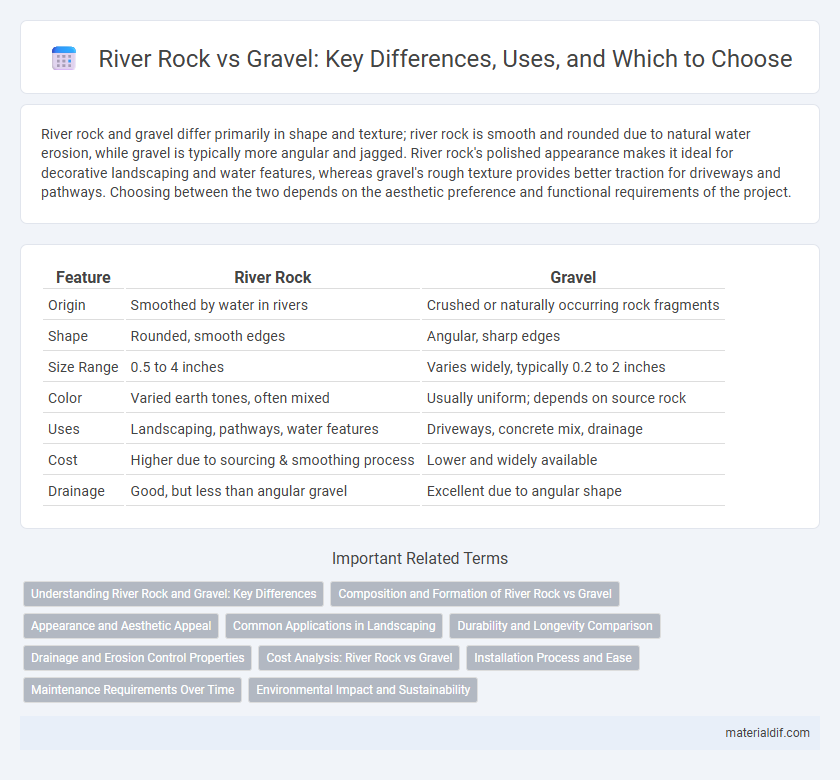River rock and gravel differ primarily in shape and texture; river rock is smooth and rounded due to natural water erosion, while gravel is typically more angular and jagged. River rock's polished appearance makes it ideal for decorative landscaping and water features, whereas gravel's rough texture provides better traction for driveways and pathways. Choosing between the two depends on the aesthetic preference and functional requirements of the project.
Table of Comparison
| Feature | River Rock | Gravel |
|---|---|---|
| Origin | Smoothed by water in rivers | Crushed or naturally occurring rock fragments |
| Shape | Rounded, smooth edges | Angular, sharp edges |
| Size Range | 0.5 to 4 inches | Varies widely, typically 0.2 to 2 inches |
| Color | Varied earth tones, often mixed | Usually uniform; depends on source rock |
| Uses | Landscaping, pathways, water features | Driveways, concrete mix, drainage |
| Cost | Higher due to sourcing & smoothing process | Lower and widely available |
| Drainage | Good, but less than angular gravel | Excellent due to angular shape |
Understanding River Rock and Gravel: Key Differences
River rock consists of naturally rounded stones smoothed by water flow in riverbeds, offering a polished appearance and varying sizes ideal for landscaping and drainage. Gravel typically refers to crushed stone or smaller rock fragments with angular edges, commonly used in construction, driveways, and concrete mixes due to its compaction properties. The key differences lie in their formation, texture, and typical uses, with river rock providing aesthetic appeal and gravel focusing on structural function.
Composition and Formation of River Rock vs Gravel
River rock consists predominantly of smooth, rounded stones formed by natural water erosion processes in rivers and streams, resulting in varying mineral compositions depending on the source rock. Gravel comprises a broader range of rock fragments, often angular and less uniform, formed through mechanical weathering and deposited in various environments like riverbeds, glacial deposits, or alluvial plains. Differences in composition and formation influence their texture, durability, and suitability for landscaping, construction, and drainage applications.
Appearance and Aesthetic Appeal
River rock features smooth, rounded edges and a variety of natural colors, creating a polished, organic look ideal for landscaping and water features. Gravel consists of more angular, irregular pieces with a uniform size and muted tones, offering a rugged, utilitarian appearance suitable for driveways and construction. The choice between river rock and gravel depends on whether a decorative, natural aesthetic or a functional, compacted surface is desired.
Common Applications in Landscaping
River rock, known for its smooth, rounded texture, is often used in landscaping for decorative pathways, garden borders, and water features due to its natural appearance and ability to facilitate drainage. Gravel, with its angular and varied sizes, is commonly applied in driveways, drainage systems, and as a base material for pavers because it compacts well and provides stability. Both materials improve soil erosion control and aesthetic appeal but are selected based on specific functional and visual requirements in landscape design.
Durability and Longevity Comparison
River rock offers natural durability with smooth, rounded edges that resist weathering, making it suitable for landscaping projects requiring aesthetic appeal and moderate wear. Gravel, composed of crushed stones with sharp edges, tends to be denser and more compact, providing greater resistance to heavy traffic and long-term erosion. In terms of longevity, gravel generally outperforms river rock in high-traffic areas due to its structural integrity and ability to interlock, reducing displacement over time.
Drainage and Erosion Control Properties
River rock and gravel differ significantly in drainage and erosion control properties. River rock's smooth, rounded texture facilitates better water flow, reducing surface runoff and promoting effective drainage. In contrast, gravel's angular shape enhances interlocking, providing superior erosion control by stabilizing soil and preventing displacement.
Cost Analysis: River Rock vs Gravel
River rock typically costs between $100 and $200 per ton, whereas gravel ranges from $10 to $50 per ton, making gravel the more affordable option for large-scale projects. The price variations depend on factors such as size, color, and regional availability, with river rock often commanding a premium due to its smooth surface and aesthetic appeal. Maintenance and installation expenses also differ, as river rock requires less frequent replacement but higher upfront costs compared to the more economical and widely used gravel.
Installation Process and Ease
River rock and gravel differ significantly in installation and ease of use. River rock typically requires more labor due to its larger size and irregular shapes, demanding careful placement and occasional leveling to ensure stability. Gravel, being smaller and more uniform, allows for quicker spreading and compaction, making it a more user-friendly choice for DIY projects.
Maintenance Requirements Over Time
River rock requires less frequent maintenance due to its smooth, rounded edges that resist compaction and erosion, making it ideal for pathways and landscaping. Gravel, with its angular shapes, tends to compact more quickly and may need periodic replenishing and raking to maintain appearance and functionality. Over time, river rock's durability reduces maintenance costs, while gravel's flexibility offers easier adjustment but demands more consistent upkeep.
Environmental Impact and Sustainability
River rock and gravel differ significantly in environmental impact and sustainability, with river rock often harvested from natural riverbeds, potentially disrupting aquatic ecosystems and habitats. Gravel, typically sourced from quarries or mined from sediment deposits, may have less direct impact on living waterways but involves energy-intensive extraction and transportation processes. Sustainable choices favor locally sourced, recycled, or crushed gravel options to reduce carbon footprint and preserve natural river environments.
River Rock vs Gravel Infographic

 materialdif.com
materialdif.com